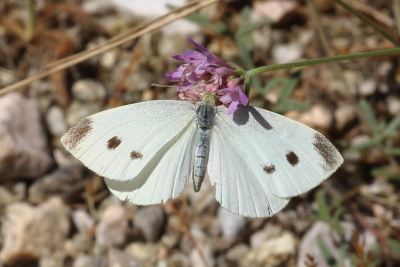











Small White (Pieris rapae)
2025 photographs highlighted in green. Click on any photograph to go to an enlarged picture, or simply scroll down the page.
|
Undoubtedly the most common butterfly in Europe. It has three to five generations in lowland regions, one or two in mountainous areas. The first brood is quite lightly marked compared to the summer brood. |
It is very similar to the Southern Small White (P. mannii) (see the mannii page for distinguishing features) which is quite common, perhaps even more so than rapae, in southern Var. |
| ref | sex |
observations |
alt. m |
| 14795 | M |
a first brood male. |
185 |
| 17219 | M |
a male of the summer brood, with a rather small post-discal spot. There are some distinct differences to typical mannii, especially the thickness of the apical mark and that it extends down the margin only to around v5, not low enough for typical mannii but lower than I would expect for rapae (H&R says rapae extends to v7 or v6, and mannii to v4 or v3). Does the spot have a straight external edge? Very hard to say. It almost seems like an intermediary form between rapae and mannii, but I don't believe these exist. On balance, it may be rather closer to rapae than mannii. |
1875 |
| 47773 | M | a first brood male, exceptionally lightly marked. | 60 |
| 47884 | M | a first brood male, quite lightly marked, but nowhere near the extent to which 47773 is unmarked. | 60 |
| 52022 | M | I believe this to be a first brood male as I would expect the two upf post-discal spots to be much stronger if it were a female, and would expect the basal dusting to be heavier for a female also. | 320 |
| 51585 | F | a second brood female, the only female upperside image I have. 51587 is the underside. | 1340 |
| 47993 | M | a first brood male. The unh ground colour is a very dark yellow and there are two factors that suggest that 47993 could be mannii, except that it isn't (for even stronger reasons): 1) the grey scales are spread across the whole of the unh surface, normally an indicator of mannii, and most significantly 2) there is no fork on vein 7, normally the near-definitive indicator of mannii. As I understand it, it is just possible for mannii to have a small, maybe very small, fork here, giving rise to some doubt, but I have never seen any evidence or suggestion that rapae may NOT have a fork. However, the fact that it was seen in the UK and mannii has not arrived here (although its northwards progression suggests that it may cross the channel in the not-too-distant future), and - conclusively - the unf post-discal spot is rounded at the external edge, says it has to be rapae. | 60 |
| 7965 | M |
a male of the summer brood. Another mannii/rapae conundrum: one expert has opined that this is actually mannii and he may well be right. It has a fork, albeit very small and significantly smaller than most rapae forks, and this particular expert has asserted that mannii CAN sometimes have a very small fork; if this is the case, the question arises as to how forked does it need to be to be rapae? Where is the dividing line? Lafranchis, in TLID, says rapae v7 "often forked" and mannii v7 "not forked"; quite categorical here. In addition, the grey scales seem almost evenly spread above and below the cell - indicative of mannii. The forewing margin is quite rounded, also an indicator of mannii. In favour of rapae is the strong lemon yellow ground colour. So, plenty of conflicting evidence here. Any input which would clarify or qualify any of these factors would be welcome.
However, since then I have spoken to one of the UK's leading experts who says that exceptionally mannii can have a very small fork. Additionally, Matt Rowlings has pointed out that the scale-free region in the cell is a sure pointer to rapae (compare with 17921 on the mannii page). |
900 |
| 54043 | F | a female, based on the markings. The unusual pose is explained by the fact that it had been seized by a crab spider. | 570 |
| 40696 | M? | clearly rapae, as can be seen from the fork in vein 7. I suspect it is a male from the pose and the apparently lighter dusting of grey scales on the unh. | 200 |
| 20832 | PAIR |
a mating pair. These can be clearly identified as rapae rather than mannii as the forewing vein 7 is clearly forked (see mannii page). |
10 |
| 51597 | ? | I don't believe there is a way to differentiate the sexes on an underside view alone. | 1340 |
17219_male_Alpes-Maritimes_04Jul09
47773_male_UK, Hertfordshire_1May21
47884_male_UK, Hertfordshire_16May21
54043_female_Pyrénées-Orientales_13Jul25
47993_male_UK, Hertfordshire_30May21